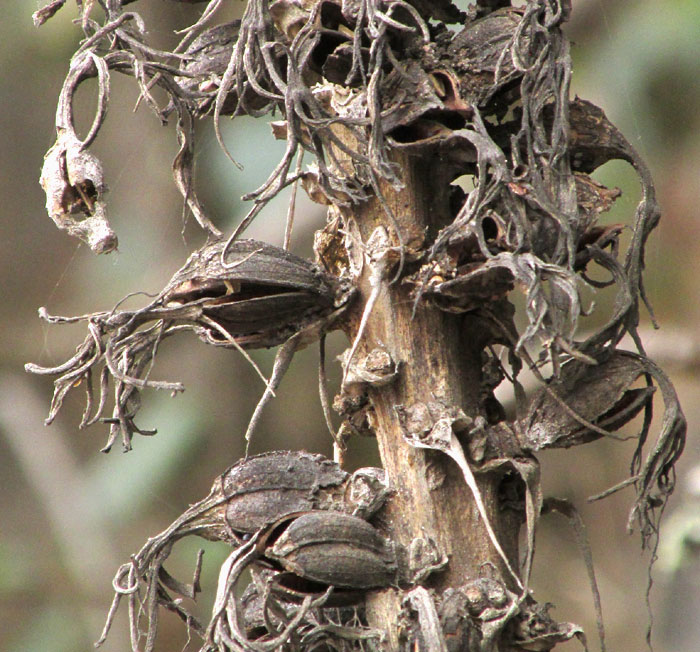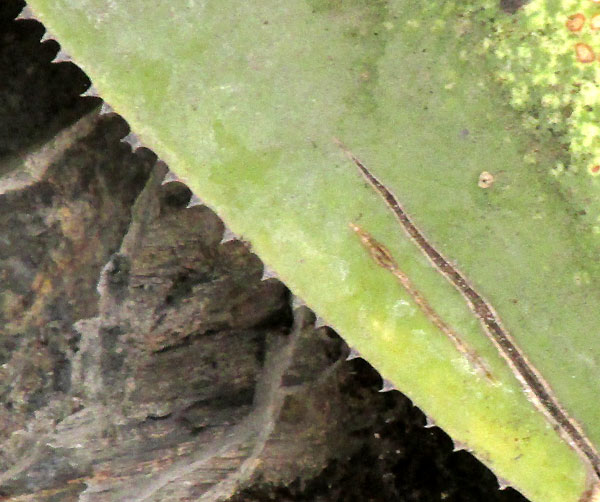Excerpts from Jim Conrad's
Naturalist Newsletter
entry from field notes dated January 19, 2023, taken in disturbed areas and along Hwy 120 on the north and east side of town, elevation ±2,380m (7600 ft); bedrock of Cretaceous limestone, in the Eastern Sierra Madre mountains; walking distance of Pinal de Amoles, Querétaro state, MÉXICO,(N21.137°, W99.622°)
MAGUEY DE PEÑA

On an old, south-facing roadcut beside Hwy 120, the above agave clung to vertical limestone face. When I looked around, others were found showing more fieldmarks for identification, which is fortunate, because agaves can be hard to identify.

In one place an old plant had flowered and fruited, as new plants, or "pups," sprouted from the dying mother. Above you see how the mother's long, semiwoody stalk curved downward, then upward, at its tip bearing mature fruits.

The fruits, seen above, were capsular, splitting along their sides to release seeds. Our plant's capsules were old and mostly the seeds already had been dispersed. However, the flowers' stamens, stigmas and styles remained atop the fruits, now brittle with drying, and blackened. Also in the above picture it's seen that the fruits appeared to arise directly from the stalk, or from a low, thick stump. Below each fruit's point of attachment there was a scale-like modified leaf, or bract, that was fairly slender, and narrowing to a sharp tip.

Leaf margins were armed with short, hard, sharp-pointed teeth.
No recent treatment of this area's agaves is available. In the past, many species names were published, often based on non-flowering material, and frequently using characteristics now deemed undependable. One problem has been that individual agave plants typically produce flowers only after 8-20+ years. In the past, explorers would send seeds to European botanists, often with poor or missing information on the seed plant's location, and if the young leaves looked curious, the plant would have a new name published for it.
I identified our roadcut agave by searching -- after all technical efforts had failed -- on the keywords "agave" and "Pinal de Amoles." Fortunately, Dra. Laura Elvia Uribe Lara had uploaded to the inaturalist.org website an identified picture of a sterile plant with leaves similar to ours. It was labeled as Agave mitis. The next lucky break was finding the 2016 work by Joachim Thiede entitled "A review of Agave mitis (Asparagaceae/Agavaceae)," providing several illustrations and detailed descriptions of Agave mitis. The pictures and descriptions nicely matched our plant.
So, we have AGAVE MITIS, a plant deserving a special publication just about it, because in the past there was such confusion about it. Thiede tells us that "Twenty-five species and varietal names now placed in the synonymy of A. mitis were published between 1856 and 1914." Moreover, "Between 1848 and 1859, all new taxa except A. celsii were published from sterile, non-flowering rosettes."
Agave mitis as it's currently understood is endemic just to northeastern and east-central Mexico, mainly in the eastern Sierra Madre mountains. The species inhabits arid desert scrub environments, humid rock cliffs and even cloud forests, where sometimes it grows on trees. In the North it's sold as a plant appropriate for rock gardens and pots, under a variety of English names, which can change from dealer to dealer. Various cultivars have been developed, such as the 'General Zaragoza.' In Spanish-speaking Mexico, there's fair agreement that our plant can be called Maguey de Peña, Maguey being the famous agave producing sap for the drinks tequila, mezcal and pulque, and the word peña referring to a rocky mountain.
There's little documentation of traditional uses of Agave mitis, but all agave species are recognized as particularly worthy plants, especially those with strong fibers in their blades, and those whose sap is fermented for drinks. And many are grown as ornamentals. Agave flowers often are edible. All 250 or so Agave species are native American, mostly inhabiting hotter, drier areas.